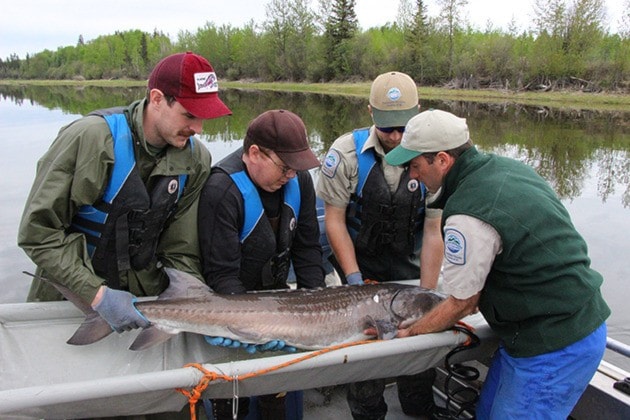Vanderhoof’s oldest living resident might just have been found this spring.
Lured by fresh salmon, the mature female sturgeon, estimated to be 100 years old, was caught by the Nechako White Sturgeon Recovery Initiative staff in late April.
Weighing 150 kilograms, the Nechako White sturgeon is one of the largest of the endangered species that the crew has seen so far, said Cory Williamson, hatchery manager of the Nechako White Sturgeon Conservation Centre.
Caught as part of the initiative’s annual broodstock capture program that started at the beginning of April this year, the female is now tagged with a radio transmitter for tracking, and will reside in the hatchery for two years — when she’s expected to produce eggs in 2018, Williamson explained.
Each spring before sturgeon spawn in the Nechako River, crews monitor reproductive adults — caught fish is measured and radio-tagged, and spawn-ready ones are kept for their eggs and sperm. This year, a total of 160 hooks on 11 lines were set along the Nechako River downstream of Burrard Bridge for the program, and the centre now has five males and five females with various expected spawn times.
Through an acoustic three-dimensional virtual positioning network of ping receivers installed along the river, NWSRI staff aims to understand why the sturgeon are spawning in certain locations.
“The river is big, not like a stream where you can turn over rocks,” Williamson said, adding that adults seem to favour turbulent flow, which may be caused by uneven river bottoms that allow eggs to settle and be hidden from predators.
By raising juvenile fish in the hatchery before they are released into the wild, NWSRI looks to increase their chances of survival and restore the endangered species’ population, which is believed by scientists to have decreased from over 5,000 to 300 in the last 50 years.
Female sturgeon spawn once every three to 10 years, while males can spawn every other year — dependent on fat reserves and their ability to find enough food, Williamson said.
“If they are older, it takes them longer to produce,” he said.
Fish are also injected with an antibiotic that stains an external point on its body, allowing staff to check the number of rings from the initial mark and gauge whether they are aging properly.
The majority of the Nechako white sturgeon’s current population is over 40 years old, which means that sturgeon are not spawning successfully or the youth are not surviving to adulthood. Adult sturgeon only start spawning when they are 20 to 40 years old.
Other current research projects on the sturgeon and its habitat include measuring larvae — baby sturgeon — to see how temperature affects their growth and development, and measuring how much water and sediment is moving down the Nechako.
